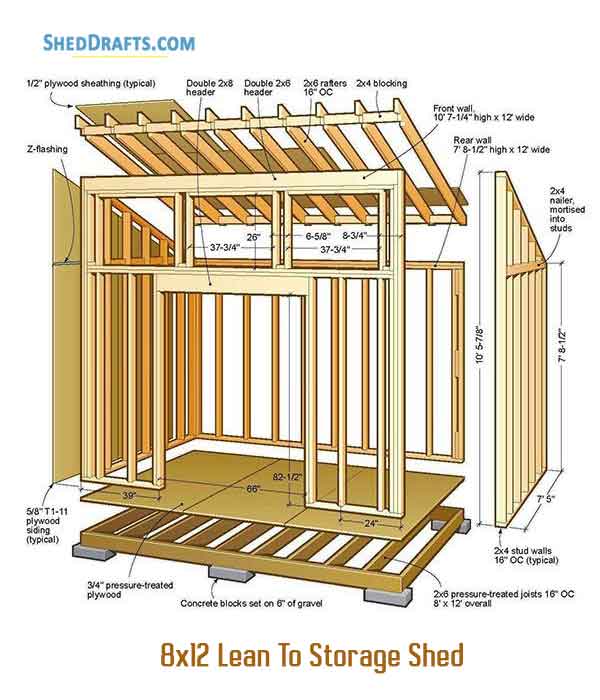
Alright, you're ready to tackle that shed project, eh? You're looking for something simple and cost-effective, a good 8x12, and you want to get started today. That's the spirit! I'm all for DIY, and I'll help you out with some basic plans and tips to get you going.
Let's Talk Basics:
Foundation: For an 8x12 shed, a simple concrete slab foundation is probably the most cost-effective option. You could go with piers or even pressure-treated wood, but concrete is generally more stable and durable.
Framing: You'll want pressure-treated lumber for the bottom plates and sill, and standard framing lumber for the rest. Consider using 2x4s for walls and rafters, and possibly 2x6s for the floor joists, depending on the load you're expecting.
Roof: You can go for a simple gable roof, which is easier to build than a hip roof. Choose a good quality roofing material like asphalt shingles or metal roofing.
Siding: You've got a lot of choices here. If you want to keep costs down, consider using plywood siding or simple vinyl siding.
Step-by-Step Breakdown
Okay, now let's get into the nitty-gritty.
1. Planning and Permits
First things first, you need to get a clear idea of what you want your shed to look like. This is the fun part! Think about:
How will you use it? Storage? Workshop?
Will you need a door? Maybe even a window?
What kind of roof do you want? Gable, hip, or something fancier?
What material will you use for the exterior?
Once you have a good mental picture, sketch it out on paper or even try a free online shed planner.
Next, check with your local building department to see if you need a permit. Some areas are pretty lenient, while others have strict requirements.
2. Building the Foundation
Now it's time to lay the groundwork (literally!).
Mark your space: Measure and mark out your 8x12 area on the ground, using stakes and string.
Dig your foundation: Excavate the area to a depth of about 6 inches. This is where you'll pour your concrete slab.
Add gravel: Pour a layer of compacted gravel in the bottom of the excavation, about 3-4 inches deep. This will help with drainage.
Formwork: Build wooden forms around the perimeter of your foundation using 2x4s or 2x6s. Make sure they're level and plumb!
Pour the concrete: You can usually buy ready-mix concrete from a local supplier. Pour it into your forms, making sure it's level and smooth. Let it cure for at least 24 hours, preferably longer.
3. Framing the Floor
Once the foundation is set, you can start building the floor.
Install the sill: Attach pressure-treated sill plates to the top of your foundation using concrete anchors or lag bolts. These sill plates will form the base of your floor.
Floor joists: Install floor joists across the sill plates, spaced 16 inches apart. Make sure to use joist hangers for proper support and connect the ends of the joists securely to the sill plates.
Subfloor: Lay down plywood subflooring on top of the floor joists. Make sure to fasten it securely using screws or nails.
4. Framing the Walls
Now it's time to get those walls up!
Wall plates: Attach pressure-treated bottom plates to the sill plates. These plates will form the bottom of your walls.
Wall studs: Stand up the wall studs, spacing them 16 inches apart. Remember to use blocking between studs for extra support, especially near doors and windows.
Top plates: Attach top plates across the tops of the studs, forming the top of the walls.
5. Building the Roof
This is where things start to take shape!
Rafter layout: Decide on the pitch of your roof. Gable roofs are usually 4/12 or 6/12 pitch. Measure and mark the location of the rafters on the top plates of your walls.
Cut and install rafters: Cut the rafters to length and install them on top of the wall plates, making sure to secure them with proper rafter hangers.
Roof sheathing: Install plywood sheathing over the rafters to create a solid base for the roof covering.
6. Finishing Touches
Roof covering: Now it's time to add the roofing material. You have several options: asphalt shingles, metal roofing, cedar shakes, and more.
Siding: Install your chosen siding material over the wall framing.
Doors and windows: Hang your doors and windows, making sure to properly seal them around the edges.
Interior: You can finish the interior of your shed with drywall, plywood, or even just paint the walls.
Insulation: If you plan to use the shed in cold weather, you'll want to add insulation to the walls and roof.
Tips and Tricks for Success
Be Patient: Building a shed takes time. Don't rush the process or try to take shortcuts.
Get Help: If you're not comfortable with certain tasks, don't be afraid to ask for help from a friend or family member.
Plan Ahead: Measure twice, cut once. Make sure you have all the materials you need before you start building.
Use Quality Materials: Invest in good quality lumber and hardware. This will help ensure that your shed is durable and lasts for years to come.
Take Breaks: It's easy to get caught up in the project and forget to take breaks. Step back, stretch, and get some fresh air.
Enjoy the Process: Building a shed is a rewarding experience. Take your time, have fun, and be proud of what you create.
And That's a Wrap
There you have it! A basic breakdown of how to build your own 8x12 shed. Remember, these are just basic plans and instructions. There are plenty of resources online and in your local library that can provide more detailed plans and information.
Go forth and build! And don't forget to share your progress and finished shed with me. I love to see DIY projects come to life!
No comments:
Post a Comment